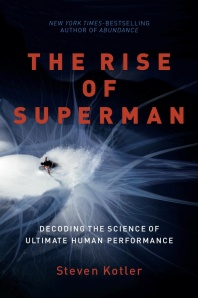 We’ve all seen athletes that appear to be operating on a different level than anyone else. We typically use the term “in the zone” to describe this focused state. The athlete or individual can’t seem to do anything wrong. It’s Michael Jordan in the ’86 classic against the Celtics. It’s Shaun White in the middle of an X-Games run.
We’ve all seen athletes that appear to be operating on a different level than anyone else. We typically use the term “in the zone” to describe this focused state. The athlete or individual can’t seem to do anything wrong. It’s Michael Jordan in the ’86 classic against the Celtics. It’s Shaun White in the middle of an X-Games run.
This state of being “in the zone” is now referred to as flow, an altered state of consciousness that seemingly allows us to achieve the impossible. We’ve all likely experienced it at one time or another whether it was when we’re participating in a sport or putting words down on a page; the work seems…effortless.
In his book, Rise of Superman, Steven Kotler describes the 10 characteristics of achieving flow:
1. Clear goals: Expectations and rules are discernible and goals are attainable and align appropriately with one’s skill set and abilities.
Clear goals is one of the most important aspects of flow for three reasons:
- It identifies the task
- It aligns the task with our belief (why we’re doing it)
- It focuses our attention
The last portion, the bit on attention, might be the most impactful. You may have seen the invisible gorilla experiment before. Participants are asked to watch a video featuring a team group of basketball players passing a ball back and forth. The task is to count the number of passes throughout the entire video. In the middle of the video, someone in a gorilla costume walks into the middle of the circle and then walks off. Amazingly, in test after test, people fail to spot the gorilla.
By setting extremely clear goals for the task at hand, we can avoid the “invisible gorilla effect” and hone our attention on the now.
2. The challenge level and skill level should both be high.
3. Concentration: A high degree of concentration on a limited field of attention.
4. A loss of the feeling of self-consciousness: The merging of action and awareness.
In many cases, flow states can generate out of body experiences. This isn’t just one person’s account either. It’s consistently reported by the world’s top performers when they’re performing at their best. Brain research has indicated that these out of body experiences are plausible.
The pattern of brain activity believed to create out of body experiences was first identified in Tibetan Buddhists that reported “absolute unitary being,” or basically feeling one with everything.
Neuroscientist Andrew Newberg and neuropsychologist Eugene D’Aquili put both Buddhists and nuns inside of a SPECT (single photon emission computed tomography) scanner. The scientists discovered a critical part of the brain, the orientation association area (OBB), that goes hypofrontal, meaning it decreases in activity. Kotler explains:
When functioning normally, the OAA is a navigation system. It judge angles and distances, maps course trajectories, and keeps track of our body’s exact location. But to do this last part, the superior parietal lobe must also produce a boundary line: the border of self, the division between finite “us” and the infinite “not us” that is the rest of the universe.
5. Distorted sense of time: One’s subjective experience of time is altered.
This relates back to the out of body experiences explained above. Time, like our sense of self, is moderated by multiple brain areas across the prefrontal cortex. Since some of these brain areas are hypoactive during periods of flow (they have less activity), our ability to compute time is disrupted. Instead, our sense of time is normally captured in rhythms of the activity at hand. Csikszentmihalyi explains in Flow:
The objective, external duration we measure with reference to outside events like night and day, or the orderly progression of clocks, is rendered irrelevant by the rhythms dictated by the activity.…
6. Direct and immediate feedback: Successes and failures are apparent, so behavior can be adjusted as needed.
Immediate feedback “refers to a direct, in-the-moment coupling between cause and effect,” explains Kotler. In moments of flow, we have a direct sense of whether our actions are generating the desired effect or not, and we can immediately adjust if necessary. Take, for example, Laird Hamilton surfing the wave zone Teahupoo. While he’s in the middle of the wave, each action Laird makes has immediate repercussions.
To apply this principle to our own work, Kotler advises tighter feedback loops:
Think daily reviews. Studies have found that in professions with less direct feedback loops— stock analysis, psychiatry , and medicine— even the best get worse over time.
7. Balance between ability level and challenge: The activity is neither too easy nor too difficult.
Scientists have identified an optimum level of emotional activation (straddling anxiety and boredom) known as the flow channel. Achieving this state requires an activity that is difficult enough to prevent boredom but not too difficult that we get overloaded with fear. Scientists have actually quantified how difficult a task must be:
…the general thinking is about 4 percent…That’s the sweet spot. If you want to trigger flow, the challenge should be 4 percent greater than the skills.
The difficulty level of a task is important because it keeps us focused on the activity at hand. If you’re doing something with a low difficulty level, your mind tends to drift (think: driving to work, which you’ve likely done thousands of times). When the activity is just past our ability level, it creates a degree of uncertainty; we aren’t sure exactly what’s going to happen. This triggers a release of dopamine, a brain neurotransmitter that heightens awareness (among many other effects).
8. A sense of personal control over the situation.
9. The activity is intrinsically rewarding, so action is effortlessness.
Peak experiences, also termed flow experiences, have been shown to be a necessary element of happiness. In addition, intrinsically rewarding activities have been shown to reduce the hedonic adaptation effect allowing us to stay happier for longer.
10. Absorption: narrowing of awareness down to the activity itself.





